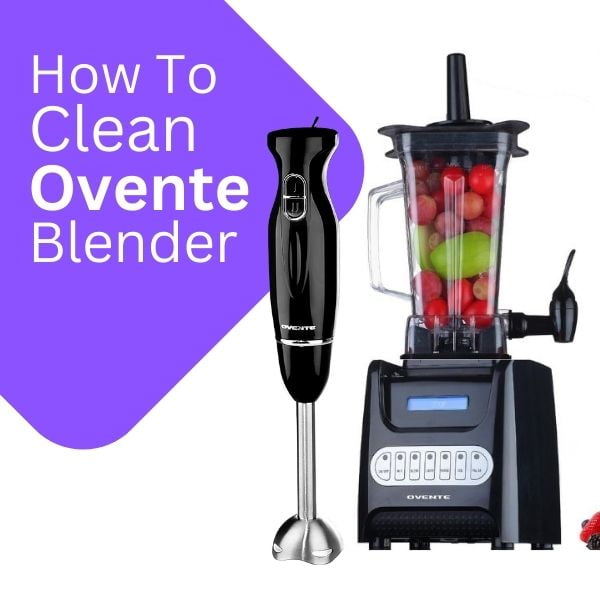Blenders are our kitchen comrades in crime, whipping up everything from silky smoothies to chunky salsas. But with two main types – countertop and immersion – choosing the right one and mastering its cleaning can be a whirl. Fear not, culinary adventurers! This “Cleaning Ovente Blender” guide will be your roadmap to blending bliss, covering both blender types and cleaning hacks for your trusty Ovente Blender.
How To Clean Countertop Ovente Blender:
These powerful machines reign supreme over large batches and tough ingredients. Picture creamy nut butters, frozen fruit margaritas, and steaming hot soups.
Cleaning Your Countertop Ovente:
- Unplug and disassemble: Safety first! Disconnect the power and remove the pitcher and lid.
- Warm water rinse: Most Ovente blender pitchers and lids are dishwasher-safe, but check your manual. For handwashing, use warm soapy water and a bottle brush for nooks and crannies.
- Wipe down the base: A damp cloth is your friend for the motor base. Avoid submerging it.
- Blade bonanza: For stuck-on bits, fill the pitcher with warm water and dish soap. Blend for a few seconds, then rinse thoroughly.
How To Clean Immersion Ovente Blender:
Compact and portable, these handheld heroes blend directly in pots, bowls, and even measuring cups. Think silky soups, zesty pesto, and fluffy whipped cream.
Cleaning Your Ovente Immersion Blender:
- Detach and rinse: Unplug and twist off the blending shaft. Most Ovente blades are dishwasher-safe, but consult your manual. Rinse under running water for quick cleaning.
- Warm water soak: For tougher messes, soak the blade and shaft in warm soapy water before rinsing.
- Wipe the motor unit: A damp cloth is all you need for the motor unit. Remember, no submerging!
Bonus Tips for Both Blenders:
- Sharp saviors: Blend a handful of ice cubes occasionally to keep your blades sharp.
- Portion perfection: Don’t overload your blender. Fill pitchers or containers to no more than the ¾ mark to prevent spills and ensure efficient blending.
- Hot & steamy: When blending hot ingredients, leave the lid vent open (if present) to prevent pressure buildup and splatters.
So, which blender is your blending bestie?
- Countertop cravings: If you love big batches, frozen treats, and hot blends, a countertop Ovente is your perfect match.
- Immersion adventures: For small portions, space-saving convenience, and direct-in-pot blending, an immersion Ovente is your culinary sidekick.
No matter your choice, remember, safety and proper cleaning are key ingredients for a happy and delicious blending journey. Now, grab your ingredients, unleash your inner blender master, and conquer the kitchen!
Ovente Blender Cleaning FAQs Answered
Good news! Many Ovente blender pitchers and lids are dishwasher-safe. However, always check your specific model’s user manual for confirmed dishwasher compatibility. Blades and motor units are typically hand-wash only.
Safety first! Never touch the blades directly, even when they’re dull. To clean, fill the pitcher with warm soapy water and blend for a few seconds. Rinse thoroughly under running water. You can also use a bottle brush to reach tight spots.
Unpleasant odors can be caused by leftover food particles. To combat this, blend a mixture of equal parts water and white vinegar for 30 seconds. Rinse thoroughly afterward. Lemon water or baking soda paste can also work as natural deodorizers.
For tough stains, try soaking the pitcher in warm soapy water for 30 minutes to an hour before washing. You can also make a paste with baking soda and water and apply it directly to the stain, then scrub gently with a sponge.
For the motor base, unplug your blender and wipe it down with a damp cloth. Avoid using harsh chemicals or submerging the base in water, as this can damage the electrical components.
Ideally, clean your blender immediately after each use to prevent food residue from drying and becoming harder to remove. If you’re blending multiple times a day, a quick rinse and wipe down between uses is sufficient.
Leaks can occur from worn-out gaskets or cracks in the pitcher or lid. Check for visible damage and ensure all parts are properly assembled and tightened. If leaks persist, consult your user manual or contact Ovente customer support.
Warm water is generally safe for cleaning your Ovente blender parts. However, avoid using boiling water, as it can warp the plastic and damage the seals.
A clean bottle brush with soft bristles can be a handy substitute for the original cleaning brush. Just be sure the brush head fits comfortably into the pitcher’s nooks and crannies without scratching the plastic.

